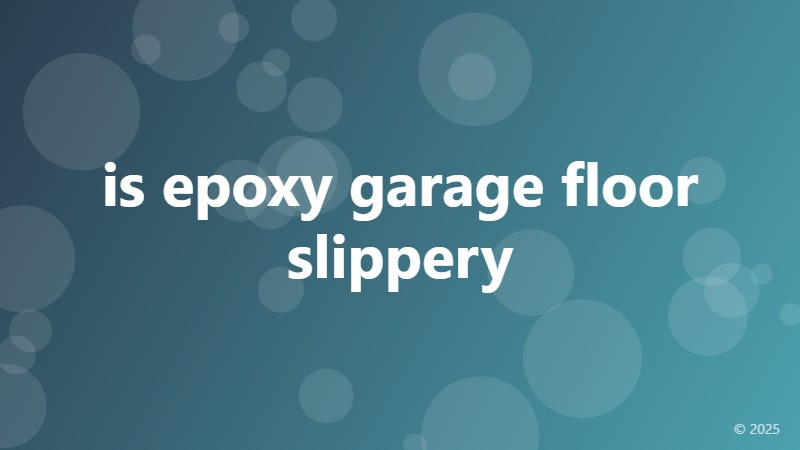is epoxy garage floor slippery
 ```html
```html
Is Epoxy Garage Floor Slippery? Understanding the Risks and Mitigation
Many homeowners choose epoxy flooring for their garages, drawn to its durability, aesthetic appeal, and ease of cleaning. However, a common concern arises: is an epoxy garage floor slippery? The answer isn't a simple yes or no. The slipperiness of an epoxy floor depends on several factors, including the type of epoxy used, the application process, and the presence of contaminants.
The Science Behind Epoxy Floor Slipperiness
Epoxy coatings themselves aren't inherently slippery when properly cured. The slipperiness often comes from the surface texture and the presence of substances on the floor's surface. A smooth, glossy epoxy finish can become more slippery when wet, similar to a polished tile floor. Conversely, an epoxy floor with a textured finish offers more friction, reducing the risk of slips and falls.
Factors Affecting Epoxy Floor Slipperiness
Several factors contribute to how slippery your epoxy garage floor might be:
Type of Epoxy
Different epoxy formulations have varying degrees of gloss and texture. High-gloss epoxy tends to be slicker than matte or satin finishes. Choosing an epoxy with a textured finish or incorporating additives that create a non-slip surface can significantly reduce the risk of slipperiness. Always check the manufacturer's specifications and consider your needs when selecting the appropriate epoxy type for your garage floor.
Application Technique
The quality of the application process directly impacts the final floor's texture and slipperiness. Proper preparation of the substrate, including cleaning and etching, is critical. Uneven application can lead to areas with differing levels of gloss, increasing the risk of slips. Professional installation often ensures a consistent and safer finish.
Presence of Contaminants
Oil, grease, water, and other substances can accumulate on any floor, making it slippery. This is especially true for garage floors, which often encounter spills and debris. Regular cleaning is essential to maintain a safe epoxy garage floor. Sweep regularly and use appropriate cleaning solutions to remove contaminants without damaging the epoxy coating.
Environmental Factors
Temperature and humidity can affect the slipperiness of an epoxy floor. Extreme temperatures or high humidity can influence the epoxy's surface characteristics, potentially increasing the risk of slips. While this is less of a direct cause, it's important to consider the climate in your area when assessing the potential slipperiness.
Mitigation Strategies for Slippery Epoxy Garage Floors
Several strategies can help mitigate the risk of slipperiness on your epoxy garage floor:
Choose a Non-Slip Epoxy
Select an epoxy specifically designed with non-slip properties. Many manufacturers offer options with added aggregates or textured finishes that increase traction. This is a proactive approach to prevent slipperiness from the start.
Add Non-Slip Additives
Some non-slip additives can be mixed into the epoxy during application. These additives increase the surface texture, improving traction and reducing slipperiness. Consult with your epoxy supplier for appropriate additives.
Regular Cleaning
Regular cleaning is crucial to prevent the buildup of oil, grease, and other contaminants that can make the floor slippery. Sweep or vacuum regularly and use a suitable cleaning solution to remove spills promptly.
Use Anti-Slip Mats
Placing anti-slip mats in high-traffic areas or areas prone to spills can provide added traction and reduce the risk of slips and falls.
Consider a Textured Finish
Opt for a textured epoxy finish instead of a high-gloss finish. A textured surface provides more grip, significantly reducing the potential for slipping.
Conclusion: Is Your Epoxy Garage Floor Slippery? It Depends.
Whether your epoxy garage floor is slippery depends on multiple factors. By carefully considering the type of epoxy used, the application technique, the presence of contaminants, and implementing preventive measures, you can significantly reduce the risk of slips and falls, ensuring a safe and durable garage floor for years to come.
```